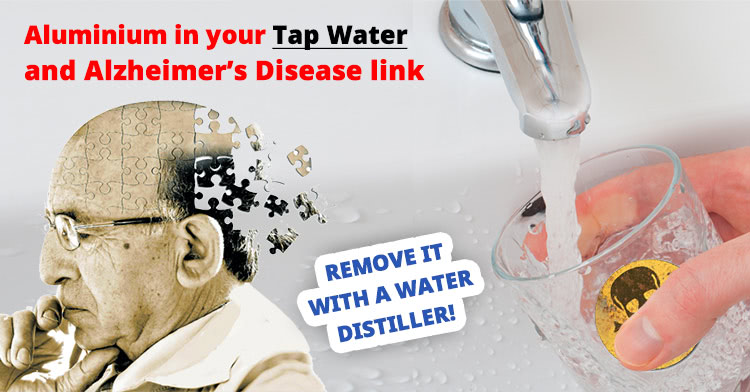
You may well know that aluminium, along with a number of other contaminants, can be found in your drinking water but did you know why it’s in your drinking water? More importantly, do you know if it’s even safe? Aluminium is already present in our soil and as a result will be found in untreated sources of drinking water such as wells. On top of this, aluminium compounds are also used to help remove any impurities at water treatment works. Aluminium happens to be very useful in the battle against cloudiness and bacterial content before the water enters the final stages of disinfection and treatment however, as a result of its use a residual amount remains in the water supply.
The legal standard for aluminium in drinking water has now been set officially at 200 microgrammes per litre however questions are still raised as to whether this is a safe amount. Concerns are also now raised due to the link between aluminium and Alzheimer’s disease. In 1989, the Department of the Environment produced a health report regarding drinking water and despite growing concern about the link between aluminium and Alzheimer’s, it was deemed unnecessary to change the “current good practice regarding the use of aluminium compounds” in our drinking water.
Despite such a powerful authority releasing a statement to assure us of its safety, the vast majority simply aren’t satisfied and quite right too, especially so soon after the Camelford Incident of 1988. In 1988, one of the UK’s most well known pollution disasters occurred at a water treatment plant located on the edge of the Bodmin Moor. Approximately 20 tonnes of aluminium sulphate managed to leak into the water supply that provided the town of Camelford.
As a result, years and years of rather bitter disputes followed due to a number of health problems experienced by those who’d drank the contaminated water. There were a number of government enquiries, accusations of a cover-up and in 2004 (sixteen years after the leak had occurred) the death of Carole Cross. Carole was a 58-year-old resident of Camelford who had died due a rather rare and quite aggressive form of Alzheimer’s disease. On post mortem, her brain was found to contain extremely high levels of Aluminium.
To give you an idea of just how high; Carole Cross’s brain contained roughly 23 micrograms of aluminium for every gram of brain compared to what are considered normal levels of 0-2micrograms per gram of brain. Professor Chris Exley was the man called in to carry out the examination on her brain and as a result of the findings was convinced that aluminium and Alzheimer’s disease were linked quite strongly with the metal playing a vital role in the early onset and hurried progression of the neurological disease.
Professor Chris Exley, a world famous aluminium expert, had hoped the inquest would highlight just how little we know about the safety of one of the most prolific metals on the planet. Prof Exley has explained that aluminium, added to nearly everything we eat, drink, inject and absorb is classed as a neurotoxin at high levels. Yet despite this, no one actually knows whether the amount of aluminium we’re ingesting is a safe amount. In spite of hundreds of publications demonstrating that the aluminum isn’t safe, there haven’t been any real investigations into the subject of aluminium accumulation in the body. Exley, a professor of Inorganic Chemistry at Keele University, Staffordshire, has been researching the subject of aluminium for over a quarter of a century.
Accumulation of aluminium; a risk factor for more than Alzheimer’s
Aluminium is the most abundant metal in the Earth’s crust and is naturally absorbed up from the soil by plants and other such foodstuffs however while we may have ingested a small amount from vegetables 50 years ago, today aluminium can be found in almost everything. When it is in the form of salts, it appears to have properties that make it a versatile and very useful additive. It’s added to our water to improve the clarity of it, it’s used as a raising agent for cakes and biscuits. It’s even used within your children’s sweets along with your tea, cocoa, malt drinks, fizzy drinks, processed foods and some wines. It also happens to be present in cosmetics, sunscreen and antiperspirants as well as in medications like aspirin, antacids and vaccinations. Yet there still appears to be no legislation that would govern just how much we should or shouldn’t be consuming.
When the amount of aluminium we consume begins to exceed what the body is able to excrete then excess builds up. This excess is then deposited in the various different tissues around the body including your nerves, brain, bone, spleen, liver, heart and muscle. Aluminium is known as the ‘silent visitor’ as it creeps into the body and begins to bed down in the bones and the brain. Prof Exley has researched everything from aluminium in antiperspirants and sun cream to the levels of aluminium found within our vaccinations and infant formula. One particular study was carried out on 16 different brands of formula for infants up to the age of one with the results showing traces of the metal exceeded that allowed in water and almost 40 times that found in breast milk. Prof Exley explained, “Everyone has some aluminium in their bodies, but infants below the age of six months are especially prone to absorbing it and not so good at getting rid of it.”
The link between aluminium and Alzheimer’s
His research in recent years has finally led him to believe that an accumulation of aluminium within the body, for example the regular dose we’re given on a daily basis of aluminium in our drinking water, is a huge risk factor for Alzheimer’s disease. It also happens to be a risk factor for other such neurological conditions too like Parkinson’s and multiple sclerosis (MS). Referring back to Camelford, Prof Exley explained that Carole Cross died of a particular type of Alzheimer’s disease known as congophilic amyloid angiopathy otherwise known as CAA.
This is an aggressive form of Alzheimer’s and is extremely rare and virtually unheard of in someone of Carole’s age. He believes Carole’s case perfectly demonstrates just how much potential aluminium has to aggravate and accelerate the disease further than normal. Prof Exley has since explained he has no doubt in his mind that the high amount of aluminium in the brain contributed significantly to an early onset of the condition in her case.
Carole Cross wasn’t the only example of a link between aluminium and Alzheimer’s however. Case in point: a relatively new case study from Keele University once again that showed unequivocally the high levels of aluminium in the brain of someone who later died of the neurological disease. Whilst we are aware that accumulated aluminium has been implicated on a number of occasions when it comes to Alzheimer’s along with several other neurological diseases, this most recent case claims to be the first direct link.
Definitive scientific proof was once thought of as difficult to gain due to the lack of longitudinal studies as well as the pushback from industries depending greatly on the use of aluminium. This recent study on a 66-year-old Caucasian man may have changed that however, after he developed a rather aggressive type of Alzheimer’s with an uncharacteristically early onset after eight years of exposure.
Defeat aluminium accumulation with distillation
With so much evidence to suggest a definitive link between aluminium and Alzheimer’s disease, along with a number of other neurological diseases, it makes sense that there should be greater effort going into ridding our water of aluminium. A recommended tolerable level was recently set by the World Health Organisation to 2 mgs per kg of body weight every week however Prof Exley had this to say on the matter, “If my colleagues around the world are unable to come up with safe tolerable levels of aluminium, then how can the WHO?”
With this in mind, it’s now clearly up to you to remove the aluminium from your drinking water. Upon hearing this, you may well begin to speculate about the great difficulty such a task could pose however that couldn’t be further from the truth. Water Pure, Europe’s leading supplier of water distillers has made this not just a possibility but an easily achievable one too. With their stainless steel water distillers, you can remove the aluminium along with 99.8% of all other contaminants within your water and all with the flick of one switch. Distillation is the only method of water purification that has the ability to create safe, clean pure water allowing you to consume all the water you need without the worry of aluminium accumulating within you or your family’s bodies over time and here’s why.
Simply put, distillation is a simple process that separates the component substances from the liquid mixture they’re within by selective evaporation and condensation. As a result of this process, distillation can result in almost complete separation creating nearly pure liquid i.e. separation of H2O from aluminium, fluoride, chlorine etc. In either case, the process of distillation works by exploiting the differences between the component substances and the liquid, which in this case happens to be their boiling points.
The water has a much lower boiling point than the substances it contains and as a result, will begin to boil and give off vapour before the substances do. The steam rises only to be collected within another chamber where it subsequently cools and turns back to its liquid form. The water collected is 99.8% pure simply because the conditions within the boiling chamber weren’t hot enough for the contaminants to boil and rise.
As a result, aluminium and other related substances remain within the boiling chamber becoming separated from the water thus no longer causing a threat to your health. The water distillers from Water Pure couldn’t be simpler to use, requiring you to fill them with water before depressing one button. The machine then does all the hard work for you delivering the 4 litres of pure water into your glass collection jug in less than four hours. If you’d like more information on water distillers or if you’d like more information on other such benefits of distilling your water then simply contact us today.
Source – Medial News Today February 13, 2014
Source – Global Healing Centre July 17, 2013


